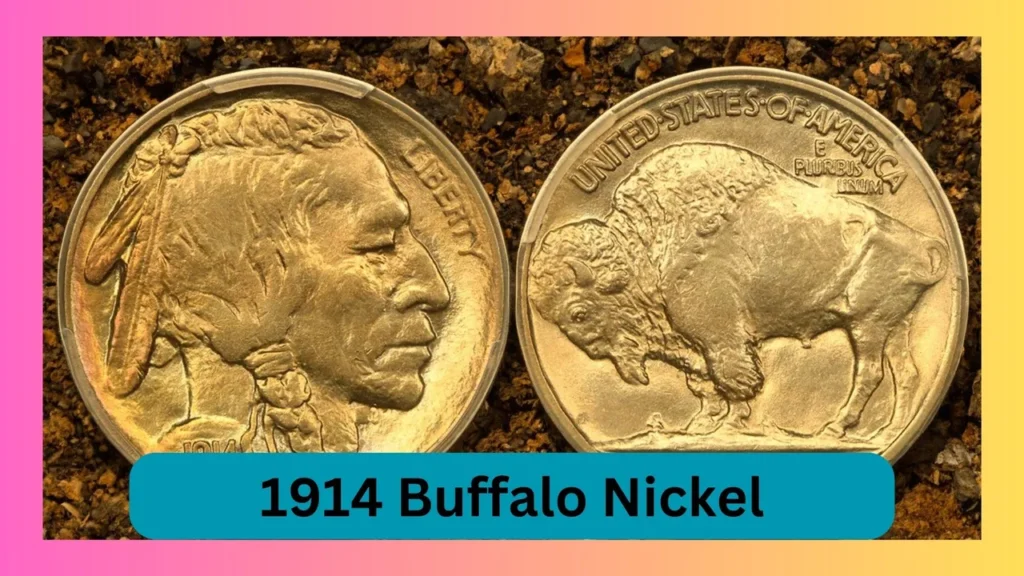Introduction
If you’re a coin enthusiast or a history buff, chances are you’ve heard of the 1914 Buffalo Nickel. This iconic piece of American coinage is more than just a 5-cent piece; it’s a snapshot of history, a sought-after collector’s item, and sometimes even a hidden treasure in someone’s pocket change. But what makes this coin so special? Why do collectors go crazy for it? Let’s take a deep dive into the world of the 1914 Buffalo Nickel and uncover its story.

The Birth of the Buffalo Nickel
A New Era in Coin Design
Before the Buffalo Nickel, the U.S. had the Liberty Head Nickel, which had been in circulation since 1883. By the early 20th century, the U.S. Mint decided it was time for a redesign to make the coins more visually appealing.
The Artist Behind the Design
The task of designing the new nickel was given to James Earle Fraser, a renowned sculptor. Fraser’s inspiration came from his love of Native American culture and the American frontier, leading him to create the now-iconic Buffalo Nickel.
The Design of the 1914 Buffalo Nickel
The Obverse (Front) Side
The front side of the Buffalo Nickel features a majestic Native American chief in profile. The portrait is actually a composite of three real-life Native American leaders:
- Iron Tail (Lakota Sioux)
- Two Moons (Cheyenne)
- Big Tree (Kiowa)
This powerful image represents the rich history and strength of indigenous tribes.
The Reverse (Back) Side
Flip the coin over, and you’ll find an imposing American bison, often mistaken for a buffalo (hence the name). The model for this design was said to be Black Diamond, a famous bison from the Central Park Zoo in New York.
The Key Details
- The word “LIBERTY” appears on the obverse side.
- The year “1914” is prominently displayed.
- “UNITED STATES OF AMERICA” and “FIVE CENTS” are engraved on the reverse.
Why is the 1914 Buffalo Nickel Special?
The Historical Context
The year 1914 was a pivotal one in world history, with World War I just beginning. Coins from this era hold extra significance due to their connection to this historical period.
Collectibility and Rarity
Among Buffalo Nickels, the 1914 issue stands out due to its scarcity and desirability among collectors. Some variations, such as those from the Denver Mint, are even rarer.
Mint Marks and Their Impact on Value
Buffalo Nickels were produced at three mints in 1914:
- Philadelphia (No Mint Mark)
- Denver (D Mint Mark)
- San Francisco (S Mint Mark)
The 1914-D Buffalo Nickel is the rarest and most valuable due to its lower mintage.
How Much is a 1914 Buffalo Nickel Worth?
Factors That Affect Value
The price of a 1914 Buffalo Nickel depends on:
- Condition (Grade) – Coins in better condition fetch higher prices.
- Mint Mark – The 1914-D is the most valuable.
- Rarity and Demand – Collectors’ demand impacts pricing.
Estimated Values
| Condition | 1914 (P) | 1914-D | 1914-S |
|---|---|---|---|
| Good (G-4) | $8-$20 | $200-$500 | $30-$100 |
| Fine (F-12) | $30-$60 | $800-$1,500 | $150-$300 |
| Extremely Fine (EF-40) | $100-$200 | $2,500-$5,000 | $500-$1,000 |
| Uncirculated (MS-63) | $400-$700 | $10,000+ | $2,000-$5,000 |
Common Issues with Buffalo Nickels
Weak Strikes
Due to the high relief of the design, many Buffalo Nickels were poorly struck, leading to weak details on the coin.
Wear and Tear
Because they were in circulation for decades, most Buffalo Nickels have heavy wear, making well-preserved examples much rarer.
Date Fading
One common issue is the date wearing off due to the coin’s raised features. This dramatically reduces the coin’s value.
How to Identify a Fake 1914 Buffalo Nickel
Look for the Mint Mark
Counterfeiters often add a fake “D” or “S” to increase value. Make sure the mint mark is genuine.
Check the Details
Authentic Buffalo Nickels have precise engravings, while fakes may have blurry or weak details.
Conduct a Weight Test
A genuine Buffalo Nickel weighs 5 grams. If it’s significantly lighter or heavier, it might be a fake.
Tips for Collecting and Preserving Buffalo Nickels
Where to Buy
- Coin shops
- Online auctions (eBay, Heritage Auctions)
- Coin shows
- Estate sales
Proper Storage
- Keep coins in airtight holders to prevent oxidation.
- Store in a cool, dry place.
- Avoid touching the surface with bare fingers.
Conclusion
The 1914 Buffalo Nickel is a fascinating piece of American history. Whether you’re a seasoned collector or just getting started, understanding this coin’s design, history, rarity, and value can help you appreciate its significance. If you’re lucky enough to come across one, take a close look—you might just be holding a small fortune in your hand!
FAQs
1. How rare is the 1914-D Buffalo Nickel?
The 1914-D is one of the rarest Buffalo Nickels, with limited mintage and high collector demand. High-grade versions can fetch thousands of dollars.
2. Where is the mint mark located on a Buffalo Nickel?
The mint mark (if present) is located on the reverse side, beneath the “FIVE CENTS” inscription.
3. How do I know if my 1914 Buffalo Nickel is valuable?
Check for mint marks, condition, and date visibility. If the coin is in great shape and has a “D” mint mark, it could be worth a significant amount.
4. Can I still find Buffalo Nickels in circulation?
It’s rare, but occasionally, a Buffalo Nickel might turn up in pocket change or a bank roll.
5. What should I do if I find a 1914 Buffalo Nickel?
Handle it carefully, check for mint marks, and consider getting it graded by a professional service like PCGS or NGC to determine its true value.